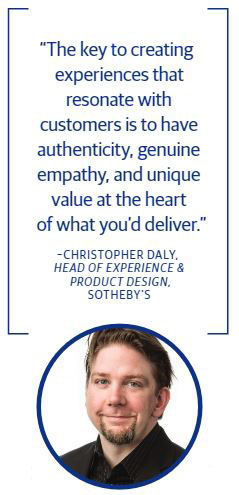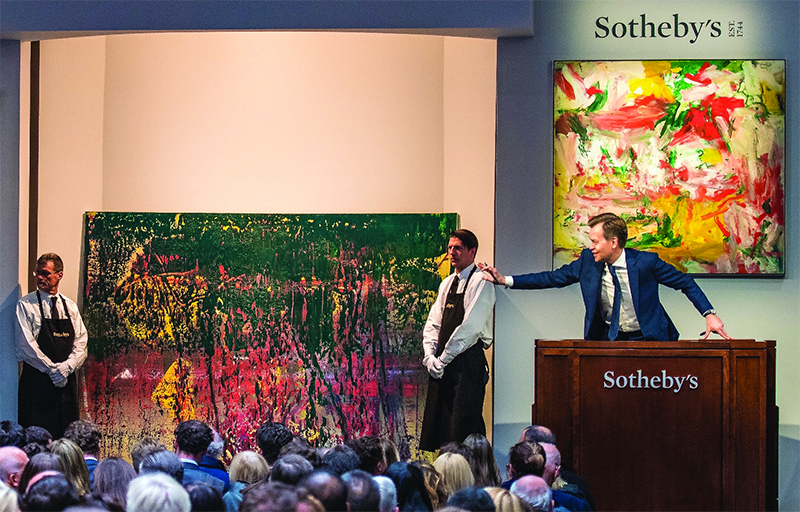In today’s competitive marketplace, your customers demand a good experience every time they interact with your company. If they don’t receive an optimal experience throughout each interaction, they will move on to the competition. There’s no question that a good user experience can pay serious dividends: Attract customers to your company and ensure they return.
Christopher Daly, vice president and head of Experience & Product Design for auction house Sotheby’s, shares how he communicates the importance of the user experience within his organization and leads his team of change associates in this very important piece of the customer journey.
Customer Strategist: What is your approach to the customer experience?
Christopher Daly: It is incredibly common to fall back on ideas like wanting to “surprise and delight” clients and customers when approaching how to execute an experience design. But I’ve always found that the key to creating experiences that resonate with customers is to have authenticity, genuine empathy, and unique value at the heart of what you’d deliver.
In most cases, customers are turning to your brand with some sense of who you are and what you offer already. With that in mind, the experiences you approach them with should feel like a natural, but enhanced, extension of what their expectations are. That’s the role of authenticity—meeting clients at their point of familiarity with your brand, but then seeking to elevate those expectations. And most often, that elevation comes from effective problem solving; that’s where genuine empathy plays a part.
Each interaction, engagement, or transaction between a brand and its customers has [in] its heart a problem to solve. Whether it is solving a problem of communicating an offer, overcoming a thorny shipping issue, or simply answering a question that is standing in the way of a sale—putting that customer problem first, through genuine empathy, is critical. And the capper is doing all this with an offering or process or system that is not just unique, but provides the customer with value they cannot get anywhere else. Authenticity, genuine empathy, unique value—that’s my approach to customer experience.
CS: What are the specific details of your job?
CD: At Sotheby’s, my role is several-fold. I manage and mentor a growing internal team of interaction, interface, and experience designers who work to support and grow our critical ecosystem of digital products—like our online bidding platform and our network of native mobile apps. I spend a lot of time partnering with the product management and business teams that own those products to help guide how they will evolve and improve. I also serve as a point person for several external creative and digital agencies Sotheby’s engages with, managing the direction of their work and acting as a liaison for them to key stakeholders inside Sotheby’s. And, perhaps most importantly, I work as a key advocate across Sotheby’s global presence to evangelize the role of digital in Sotheby’s business and future.

CS: How does your job tie into the goals of Sotheby’s?
CD: With the arrival of a new executive team at Sotheby’s in mid-2015, there has been a marked shift in the importance and role of digital experiences in the relationship we have with our clients. Sotheby’s is the oldest company listed on the New York Stock Exchange, having first incorporated in 1744, but that deep heritage should not be an impediment to being a 21st century digital leader. Our executive team has fully bought in to ensuring Sotheby’s competes via digital channels and through digital means. So in large part, my role is integral to the core of Sotheby’s goals going forward.
CS: What is your day-to-day experience like?
CD: The core of my days is split among a few key tracks: Participating in product and technology team scrums to keep eyes on what the development path ahead looks like. Daily check-ins with my design team to course correct UX solutions in the most agile way possible. Product and roadmap reviews with executives and business teams. My day-to-day can never just be about what’s right in front of me and my team. I’ve got to keep my eyes [open] to see, anticipate, and drive what is coming ahead.
CS: Why is a role like yours important to the art world, and how should it be applied to other industries?
CD: A UX and digital product design role at Sotheby’s is not just important in the “art” sense, but also in the luxury lifestyle sense. It can’t be disputed that Sotheby’s sits right at the center of the global art world, and that’s a community that puts a significant emphasis on being able to see, touch, feel, and be physically present with the works of art in order to buy or sell.
Developing digital experiences within that mindset is particularly challenging because we literally need to overcome a “wish you were here” point of view. We are working hard through storytelling and editorial, photography and video, artist details and artwork specifications, and next generation tools like virtual and augmented reality to create an authentic sense of “wow, it’s like I AM there.” Add in the fact that the luxury space—whether it’s automotive, watches, or other categories—has never really been cracked online. I think what we are creating with Sotheby’s will prove to be a template for how luxury brands around the world engage and transact with their clients—a real sense of “being there” via apps, websites, and digital experiences.
CS: What are your biggest challenges?
CD: In many respects, my team and I have been given a mandate to be change associates. And change is never easy. The biggest challenge is building consensus and buy-in among the internal groups that are most on the front lines of that change. At the end of the day, we are all on same team and share the same goals. The critical factor is how to best demonstrate how the change my team brings will, in fact, not just serve the company’s goals, but also the personal goals of those internal groups.
CS: What are some of your proudest moments?
CD: I am happy to say we are just getting started at Sotheby’s, but I am extremely proud of being able to build an internal UX design team within an organization that traditionally only ever used external vendors. I am also very proud of the success we’ve had building momentum, excitement, and buy-in across the organization for a new generation of sites, apps, and digital experiences that will sit at the center of the Sotheby’s client experience.
CS: What are some results of your work?
CD: Our work is iterative by nature, and seeks to continually improve not just customer experiences, but internal processes as well. So, in large part, the results of our work are measured through improvement over what was there before. And by measures like that, we can proudly talk about the significant year-over-year increases in the number of clients bidding online, total number of objects won by online bidders, and total value of objects won online as a percentage of all sales. Add to that the fact that the art market actually contracted this year and overall sales and growth have been under pressure. So to be able to point to growth in the online channel in the face of such a turbulent headwind—those are great results!
CS: What are some predictions you have for the 2017 customer experience?
CD: I think 2017 will see the first really viable executions of virtual and augmented reality for delivering business and customer experience value. To date, virtual reality and augmented reality have been flashy and entertaining, but they haven’t had a real impact on business or commerce. I expect 2017 will see some reversals of that position with VR and AR will become critical pieces of customer experience thinking and delivery. We’ll also see Western markets, like the United States, catch up with Eastern markets in the use of chat interfaces, like WeChat, as key drivers of client engagement and touchpoint management.
CS: What advice would you give other UX professionals?
CD: UX is not about form factors or interfaces or devices. It’s not about how amazing you design a screen. It’s about understanding how your customers/clients think, what they need, and how best to service them. Yes, digital screens will be critical in that, now and tomorrow. But with changes like the rising use of chat interfaces and voice-based services like Siri and Alexa, increasing fidelity and value of panoramic 360-degree video and VR, screen sizes themselves getting smaller with wearables, and the rise of Internet of Things devices, the idea that your UX skill set should be screen- and interface design-oriented no longer applies.
CS: What are Sotheby’s future experience plans?
CD: How we can improve the on-site customer experience during our live auctions; how we can improve the exhibition experience for customers that visit our galleries all over the world; how we can make it easier, effortless even, to not just buy from Sotheby’s, but also sell objects through us as well. While these sound like the basics, and in fact they are the here and now challenges of Sotheby’s, they are also our future and ongoing focus as well. In all, it’s about a future where customer and client centricity directs every decision and action of the company—not just in digital, but enterprisewide.






